This is part of a series on Roman Catholicism and the eucharist. See this index.
Copy-and-Paste Apologetics
A while back I did a 40-part series on the Eucharist entitled “What the Earliest Christians Wrote About the Eucharist.” It was based on a post made by Roman Catholic apologist Fish Eaters. During that series I noted how often Roman Catholic apologists engage in “copy-and-paste apologetics.”
For example:
A Google search shows that FishEaters’ quotations are extremely popular among copy-and-paste apologists. The first quotation (shown below) is attributed to “Explanations of the Psalms 33:1:10”, but it is not found in “The Exposition on Psalm 33” on New Advent, nor in the full “Expositions on the Psalms.” There is no indication where the translation comes from.
After searching, I found an explanation.
Ironically, my citations below are more accurate than dozens (or more) apologist sites. How disappointing that many blindly copy citations without checking them! This shows loose or non-existent academic integrity: a commitment to ideology over truth.
…and…
FishEaters is clearly not putting her own views to the challenge, because she doesn’t even check her references. Her errors are not accidental typos, nor are they—at the other extreme—failures to understand complex contextual language. She’s not even trying.
Most of her copy-and-paste quotes can be found exactly on a dozen other websites, with little to no change in markup, let alone links to the primary sources. Even the ellipses (“…”) are found in the same location! With the Jewish sources, she found something that seemed to support her view, so she used it without checking to see if it actually supported her view (or worse, she did check, but used it anyway).
…and…
Its worth noting that this quote is often mined out of context. [Roman Catholic apologist] Church Fathers cites this as Letter 63 ([New Advent cites it as] letter 62). The commenter that Tim Kauffman is responding to thought it was part of “Letter to the Ephesians.” The “Real Presence eucharistic Education and Adoration Association” makes the same error. The Roman Catholic apologists are not even checking their sources, let alone reading them to ensure that they say what is implied!
This comment by Tim Kauffman could just as easily been addressed to Church Fathers:
You provided a list of quotes which are proposed as evidence, I presume, that Cyprian had a Roman Catholic view of the Eucharist. Among those quotes you will find one alleged to be from Cyprian’s letter to the Ephesians in 258 A.D.. It is actually from letter 62, paragraph 14 in 256 A.D., which was not a letter to the Ephesians.
I point that out only to show that your “cut and paste” approach to apologetics does not serve you well, for it shows that you are simply cutting and pasting without familiarity with the content or context of what you are cutting and pasting. It is a good example of why you should not trust the “experts” from whom you cut and pasted it.
This is the problem with Roman Catholic apologists: they have no idea what they are talking about, and so they misrepresent the evidence. If they were more honest, like the Catholic Encyclopedia, they’d admit that the Roman liturgy doesn’t exist until the 6th or 7th century. But if they thought about what that meant, they might no longer be Roman Catholic. It’s much easier to stick your head in the sand and mine quotes.
Now a Twitter/X user @catholicfan2 is taking Timothy Kauffman to task here:

And, as we’ll see, it’s just one copy-and-paste after another (see Kauffman’s response here).
First of all, to summarise what Tim is proposing, he’s essentially claiming that the current understanding of the sacrifice of the mass (that the sacrifices Jesus made on the cross is re-presented at the mass) only came about in the 4th century, and that the “Eucharist” refers to tithe offerings.
The origin of the term “sacrifice of the mass” is the “dismissal sacrifice” because “missa” (from which we get the word “Mass”) means “dismissal” in Latin. Let’s take CatholicEnthusiat’s statement…
…and simplify it by removing the interpretation and paraphrasing:
Now that is interesting! Here is Kauffman’s view:
These are both saying exactly the same thing.
CE has added his own baggage to the terms used by the early writers (e.g. “Jesus made” and “re-presented”), but once that baggage is removed—to avoid circular reasoning—a very different picture emerges. Without adding the much later standardized language of Roman Catholicism back into history, the Roman Catholic viewpoint is no longer found there.
Furthermore, it’s not like the Roman Catholic is shining the light of clarity on the situation:
Citation: Adrian Fortescue, “The Origin of the Mass.” The Catholic Encyclopedia, Vol 9. (1910)
The Roman Catholic doesn’t have the explanation for the dismissal because Roman Catholicism has altered the liturgy from the original. CE thinks Kauffman is wrong, but CE’s church offers an insufficient alternative. In other words, CR speaks of the “sacrifice of the mass” without even knowing what the “mass” is, let alone why there is a sacrifice of it, especially because the “sacrifice of the mass” isn’t sacrificing the mass. His confidence that it refers to “the sacrifices Jesus made on the cross is re-presented at the mass” must be properly contrasted with his ignorance of what “the mass” is.
Protestants have long objected to the Roman Catholic Church using Latin and its hostility towards the laymen reading scripture in the vernacular. All of these keep the meaning of scripture away from the common man. Similarly, the common man doesn’t know what “Mass” is because it’s in a language they do not know. Roman Catholic tradition is so far removed from its history that not even the Latin-speaking priestly caste knows why it is called the “Mass.”
Kauffman has offered him the explanation, but CE doesn’t like it.
Ignatius of Antioch
However, one only needs to look at the Church fathers to refute this. St. Ignatius of Antioch writes that the heretics abstain from the Eucharist because they don’t believe it to be the flesh of Christ.
This is cut-and-paste theology. Here is what Ignatius wrote:
Citation: Ignatius of Antioch. “Epistle to the Smyrnaeans.” ¶6-7 (c.110AD)
For those who have read our series, you already know where this is going. It’s the same argument exactly that Fish Eaters made:
Notice the part that FishEaters left out in her cherry-picked quotation. It is really important. Can you see it?
The Gnostic heretics failed to care for the widow, orphan, oppressed, slave, free, hungry, and thirsty, because they did not participate in offering (or sacrifice) of thanksgiving and prayer. They did not participate because they didn’t “confess the eucharist to be the flesh of Jesus.” What does this mean?
To confess the thanksgiving [eucharist] was the act of consecrating the portion of the tithe offering used in the Lord’s Supper by saying the words of institution, just as Jesus consecrated the bread and wine after he had given it to his disciples and they had partaken of it. The church first offered the thanksgiving [eucharist] as a tithe. Then they celebrated the thanksgiving as a supper of consecrated bread and wine taken from the tithe. The thanksgiving [eucharist]—of unconsecrated tithes—was offered and the supper—of consecrated bread and wine—was eaten, not offered.
But, the Gnostics showed no regard for the needy by refusing to offer their tithes, because they denied the death and resurrection of Christ, because they denied Christ’s incarnation in the flesh. Put simply, no Gnostic could say “This is my body; This is my blood” while denying that Jesus ever had a body or blood in the first place. The Gnostics could not confess/consecrate the [already offered] tithe offering because it required them to acknowledge Christ’s body, and so did not offer any tithe at all.
As with the dismissal of the unbelievers and the unrepentant believers in the Didache’s liturgy, the Gnostics did not (and, indeed, could not) participate in the offering of the tithe or the [subsequent] celebration of the Lord’s Supper. That is why Ignatius says
…immediately preceding…
These two are intrinsically linked: they are two ways of saying the same thing.
CE’s statement leaves out the fact that Ignatius is talking about the thanksgiving (‘eucharist’) in the context of helping the poor. That’s because the eucharist is the tithe offered in thanks. By contrast, the Roman Catholic Eucharist is not a tithe offering for the poor, so the copy-and-paste apologists always leave out the preceding sentence that establishes the context of the eucharist.
The reason the Gnostics didn’t consecrate—by the words of institution—the tithe offering was because they didn’t participate in the offering of the tithe for the poor in the first place. They were dismissed. This is one of the clearest examples of the thanksgiving being a “sacrifice of the dismissal” in the early church writings.
The Roman Catholic must read this as a list of unrelated vices: first, they didn’t help the poor and second, they abstained from thanksgiving and prayer, and third, they refused to affirm the words of institutions. But these are not separate acts. They are all the “sacrifice of the dismissal” (or, “sacrifice of the mass”). Abstaining from thanksgiving and prayer—because they’d have to affirm the words of institution—is the failure to help the poor.
Or put another way, if the Gnostics had been participating in the tithe but not Lord’s Supper, then they would be showing regard for the poor and needy in the same way as everyone else. In that other hypothetical world, Ignatius would have only taken them to task for refusing to acknowledge the words of institution, and would have needed to say nothing about the poor.
Let’s go to our next copy-and-paste:
Now, Tim will undoubtedly try to argue that the “Eucharist” that Ignatius is referring to is the tithe offering that he says was the sacrifice offered at the mass before the 4th century. However, we don’t need to speculate, because in his letter to the Philadelphians, St. Ignatius tells us what he considers to be the Eucharist.
In chapter 4 of the letter, he says that there is ONE Eucharist. This is clearly inferred to be holy communion, since he talks about there being “one cup to [show forth] the unity of his blood.” There’s no evidence that Ignatius is referencing a tithe offering here.
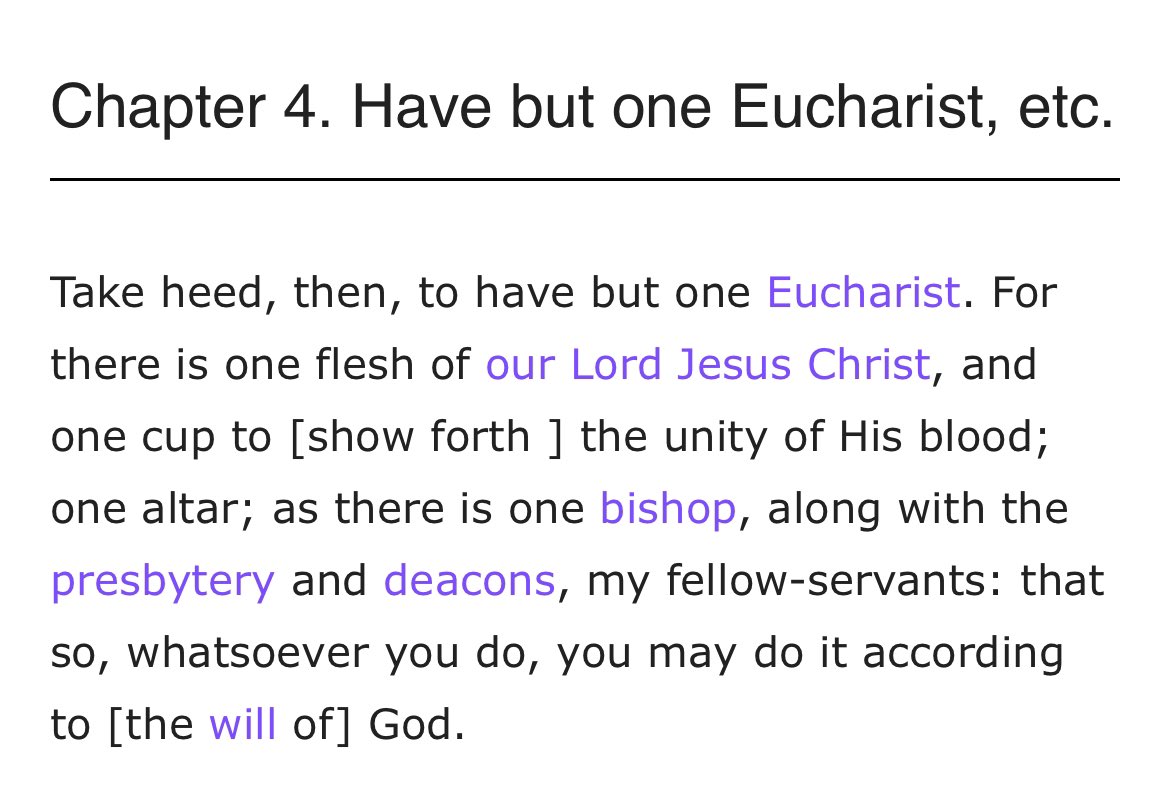
So, as we can see, St. Ignatius writing in the early 2nd century believes in one Eucharist, that Eucharist being holy communion, where Christ’s body and blood are truly present.
Well, what do you know. It’s the same quote that Fish Eaters used in our series! Here is what I wrote about that:
The quote from the Letter to the Philadelphians is extremely vague and ambiguous. It doesn’t challenge either viewpoint.
CE says “we don’t need to speculate” and “this is clearly inferred” when neither of these are true.
Does Ignatius mention ‘Holy Communion?’ No. It’s not an inference from what Ignatius writes, its an inference from Roman Catholic doctrine. That’s circular reasoning.
What makes CE’s view speculation is the simple fact that I can take this Ignatius quote unaltered to refer to a thanksgiving tithe offering. This is not difficult at all.
Or to put another way, the only reason CE thinks there is no evidence that Ignatius is reference a tithe offering is because he has already decided that the “one eucharist” is not a reference to the offered tithe. Because, quite explicitly, Ignatius does in fact mention eucharist—the tithe of thanksgiving—so it’s rather odd to say that he isn’t referencing the tithe offering, because that’s what the eucharist is. See how circular reasoning works supports both positions equally?
CE isn’t formulating a proper argument. He brings up “where Christ’s body and blood are truly present” which is a non sequitur. Ignatius doesn’t say that, so why is CE bringing his Roman Catholic theology into the discussion? It’s not relevant to the question under debate.
Yet, according to Tim, the belief of Christ’s sacrificed body and blood being re-presented at the mass only appeared in the 4th century.
Because that’s what the historical evidence shows.
Justin Martyr
However, I think it would be incredibly reductionist to just focus on one Church father, since what the early Church believed can never be encompassed in the writings of one father. What did other fathers think?
St. Justin Martyr has a variety of useful quotes, but I won’t go over all of them.
And neither will we explore each quote here. You can read them in “Part 3: Justin Martyr.”
That’s the dismissal. In Chapter 66 of First Apology, he writes that no one can partake of the thanksgiving, or offer their tithes at all, if they are not properly baptized. Those who are not eligible to participate are dismissed prior to the offering.
In Chapter 67, he says that what is offered are prayers and thanksgivings (with bread and wine and water) to help the needy. As with Ignatius, the emphasis of the eucharist is on helping the poor and needy.
He then goes on to tell us what he believes the Eucharist to be. He believes the bread and wine, of the EUCHARIST (clearly indicating he believes the Eucharist to be holy communion) is the real body and blood of Christ. So, we have another church father who believes the sacrifice of Christ is re-presented in the mass through bread and wine becoming the body and blood of Christ.
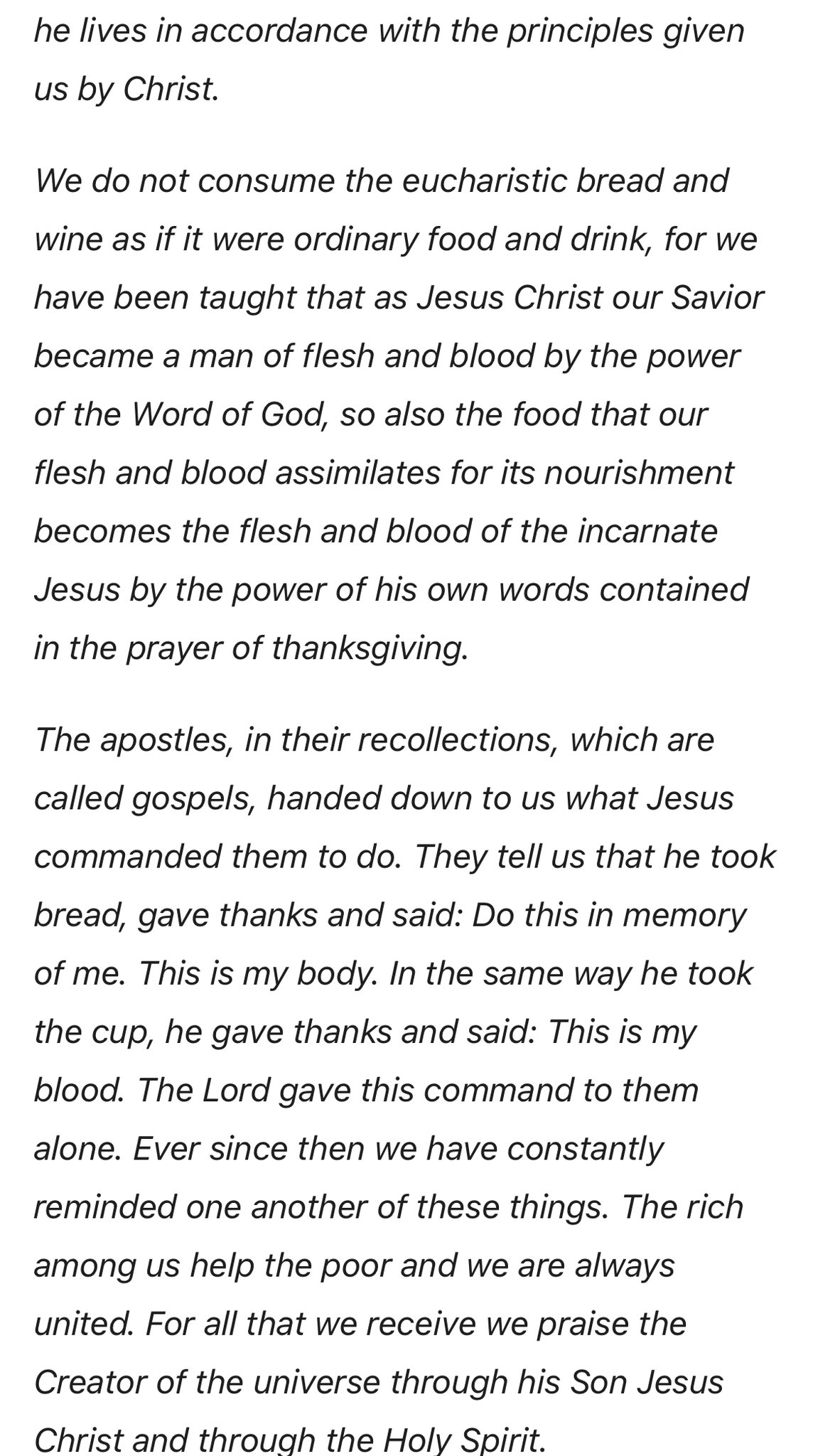
Wow, what a quote. This is, purportedly, a quote from Chapter 66 of First Apology. Notice how it is translated compared with this Roman Catholic one. The word order is quite different. Let’s compare these renderings:
by the prayer of His word…
is the flesh and blood of that Jesus who was made flesh
by the power of his own words contained in the prayer of thanksgiving…
becomes the flesh and blood of the incarnate Jesus”
And here is another:
by the prayer of His word (δι’ εὐχῆς λόγου τοῦ παρ’ αὐτοῦ)…
is the flesh and blood of that Jesus who was made flesh.”
This one comes from Roman Catholic J.P. Migne’s Patrologia Graeca (published from 1857–1866) in vol VI, cols 428-429.
Notice the progression in the translations:

First, Migne’s translation has the food “eucharisted.” It was already thanked before it was consecrated by invoking Christ’s words in prayer.
Second, the New Advent translation calls it the “food which is blessed.” Although this is somewhat unclear and ambiguous, it seems to imply that the food is now being blessed by the prayer, rather than having been already blessed. In other words, it seems to imply that the food becomes the eucharist (or literally flesh and blood) by the consecration.
Third, CE’s “translation” dramatically alters the meaning! The word “eucharistic” is no longer even a verb at all, which simply removes all possible reference to the past tense verb in the original. It is replaced by the word “becomes” as if the bread and wine become the flesh and blood of Jesus by the consecratory prayer itself, which it presumptively calls “the prayer of eucharist.” And, lastly, it uses the “bread and wine” instead of “food.” The Roman Catholic doesn’t consider the consecrated bread and wine in “Holy Communion” to actually be food (i.e. transubstantiated), even though Justin Martyr explicitly states that it is digested (i.e. transmuted) food.
This is mistranslation. It’s a biased Roman Catholic mistranslation.
One of Migne’s contemporaries, Anglican William Wigan Harvey, in 1857, was unaffected by modern attempts to spin Justin Martyr’s words into something else. Consequently, he struggled to come to terms with Justin Martyr saying that the words of institution came after the eucharistic offering was completed. So too did the Catholic Encyclopedia, unaware of the modern spin, admit in 1910 that Justin Martyr’s liturgy differed from the Roman Catholic Latin liturgies found in the 6th century and later.
But this isn’t a problem for the copy-and-paste apologist, who doesn’t need to be aware of these issues. They can just uncritically cite bad translations from obviously biased sources. Go ahead and Google search for CE’s source:
You find pages and pages and pages and pages of copying-and-pasting. As is typical with the copy-and-paste apologist, many don’t cite their source. Fortunately the National Catholic Register comes to our aide:
This translation was from Office of Readings (Daughters of St. Paul, 1983, 540-541): 2nd Reading from the Office of Readings of the Liturgy of the Hours for the 3rd Sunday of Easter.
Oh, I’m sure that work is not biased at all!
So basically, CE copy-and-pastes an insufficiently cited quotation from an explicitly pro-Roman Catholic source to defend the indefensible claim that Justin Martyr thought the thanksgiving was “the real body and blood of Christ.”
CE’s argument is a modern innovation. Worse, it is his own private interpretation that stands against the view espoused by Roman Catholics in the late 1800s and early 1900s. His epistemology leaves him, at minimum, no better off than the Protestant he is arguing against. Actually, it’s worse than that, because his epistemology has led him to assert plainly ahistorical and anachronistic claims. At least Kauffman’s claims—like those of Migne and Harvey—are rooted in historical and linguistic evidence.
So far this has not been a good showing. Let’s see what else CE’s got!
Irenaeus of Lyons
What about other church fathers from before the 4th century? St. Irenaeus of Lyon is very interesting, since he explicitly uses the word “sacrifice” when talking about the Eucharist. He writes extensively on this topic, and clearly expresses what exactly he believes. Anybody with common sense should be able to discern whether or not St. Irenaeus is talking about a tithe offering or holy communion.
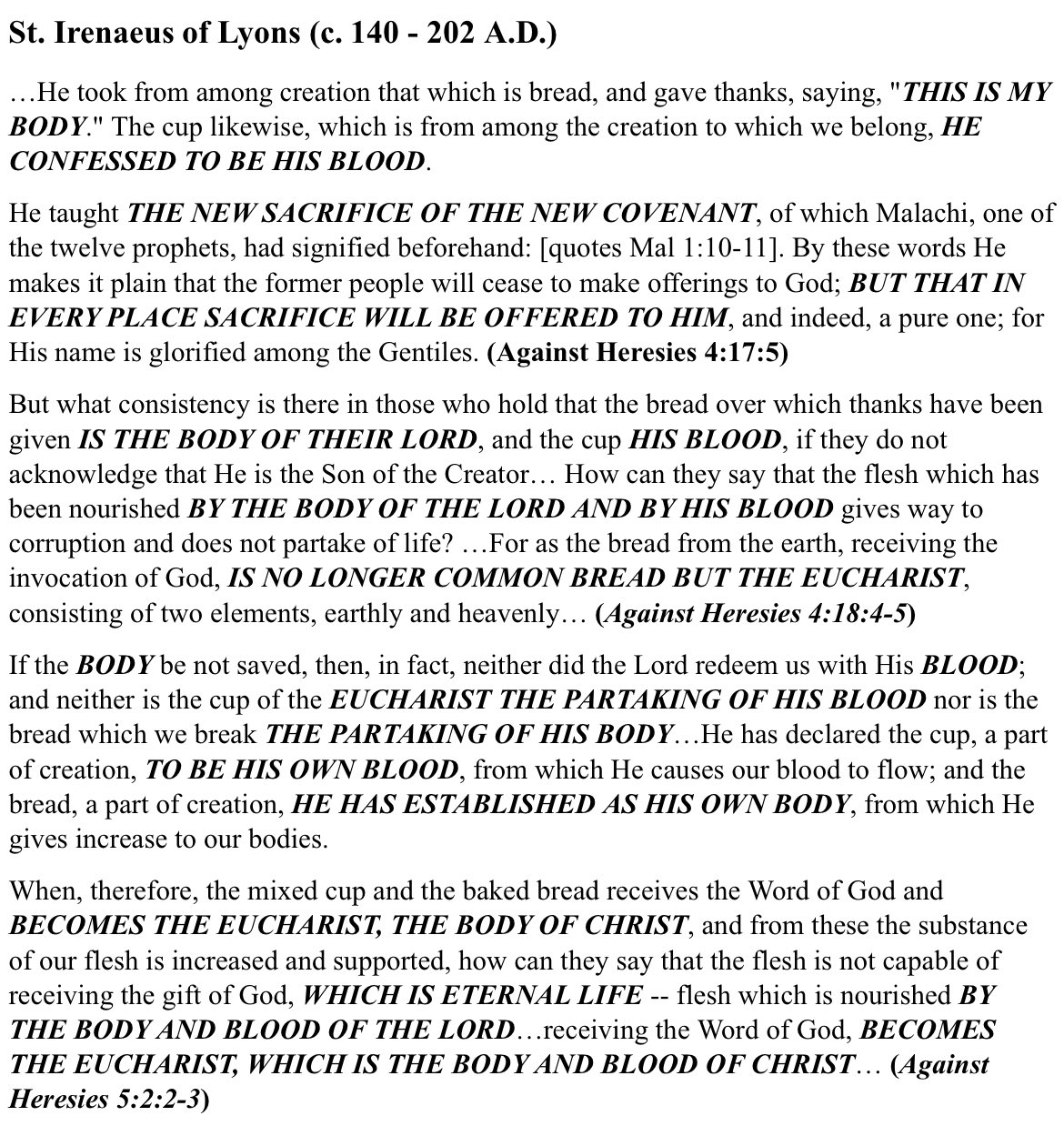
It looks like CE is a copy-and-paste clone of Fish Eaters’ citation:
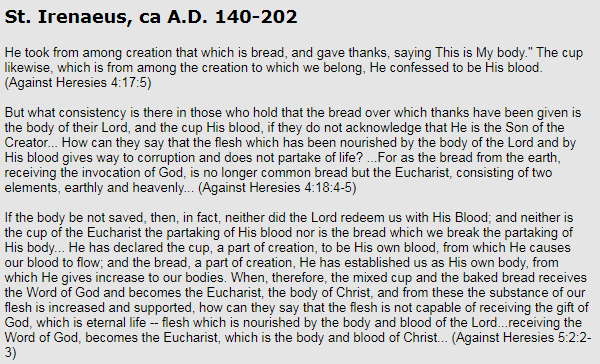
It’s almost exactly the same, complete with the same estimated dates and citation style!
It’s kind of sad that this is what passes for standard Roman Catholic discourse these days. Three sentences of explanation to go with a copy-and-paste quote dump.
You can read my full responses in “Part 6: Irenaeus of Lyons” and Timothy Kauffman’s full response in “Part 36: Irenaeus, Revisted.” You can read those for yourself, but I’ll leave my Readers with this one warning:
As an intellectually- and academically-oriented writer, I find this to be deeply offensive, especially because these mistranslations are not disclosed to modern readers by editors, apologists, and scholars. In addition to deceiving countless people, this helps to create unnecessarily hostile situations like the one that inspired this series, as well as cultivating overconfidence in Roman Catholics. It harms the possibility of dialogue
Catholic Enthusiast cites mistranslations authoritatively in two out of three church fathers.
The copy-and-paste apologist is so eager to find his view in history that he resorts to spreading—intentionally or unintentionally—outright fraud.
Clement of Alexandria
St. Clement of Alexandria says that Christ “pours out his blood” for Christians. Granted he doesn’t use the word Eucharist so perhaps this isn’t the best quote, but we can see what he believes in respect to holy communion.

What do you know? CE uses the exact same quotation that Fish Eaters copied-and-pasted.
My detailed response is found in “Part 7: Clement of Alexandria.” To refute the claim made by CE, all you need to do is expand the quote to include more of the immediate context. There you will see things like this…
…and this…
In his other writings you will see things like this…
…and this…
…and this:
(Please feel free to read those quotes in their proper context)
If that’s the best argument that CE has, he’s not doing well at all. Clement describes the body and blood of Christ as symbols and figures. We agree with Clement and so reject Roman Catholic’s abominable, ahistoric views.
Cyprian of Carthage
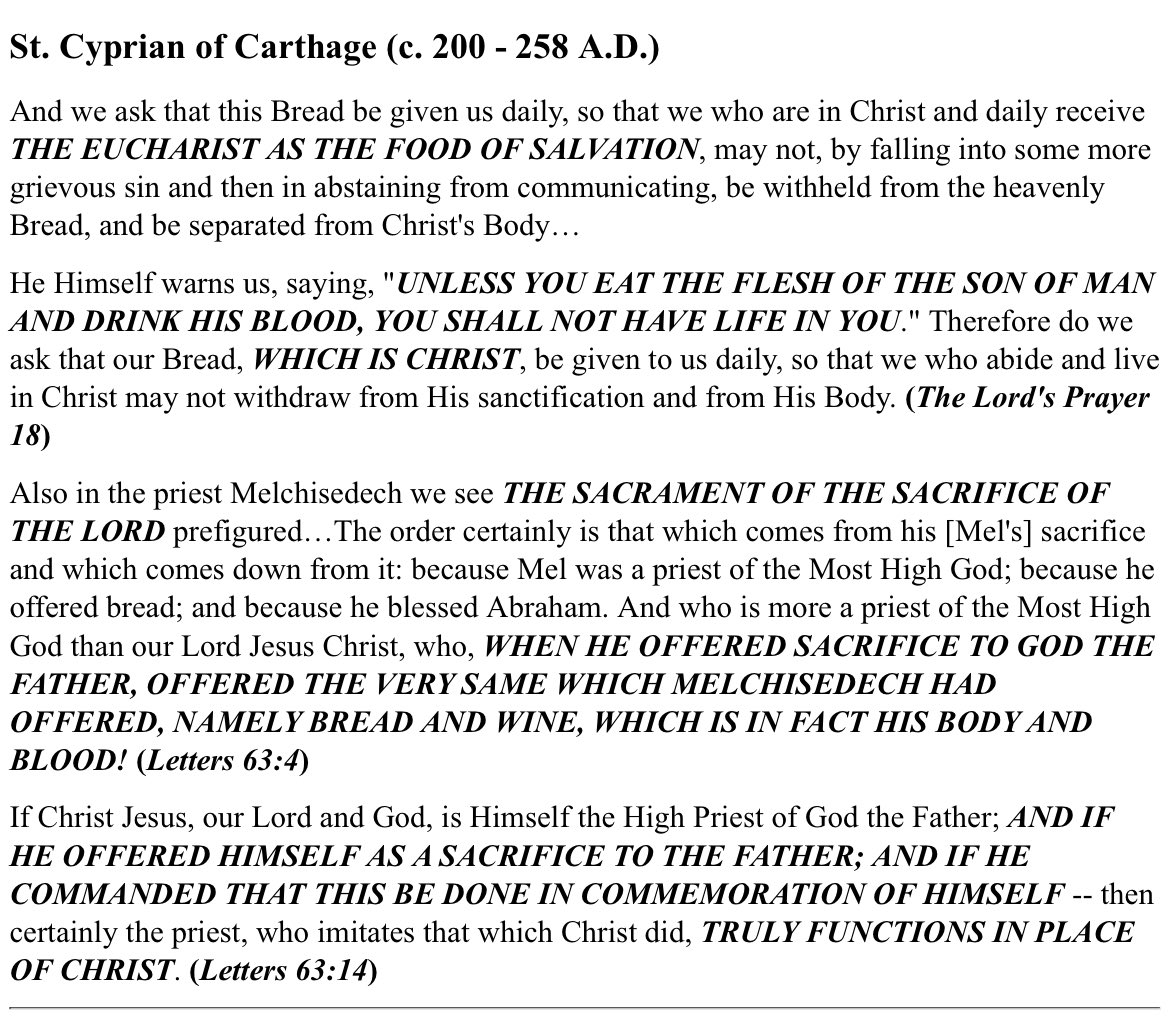
My Response is found in “Part 11: Cyprian of Carthage” and in “Part 32: Interlude.”
Regarding “The Lord’s Prayer” Cyprian differentiated between the unconsecrated tithe offering and the consecrated bread and wine. He called both of them eucharist because both of them involved the same bread and wine, just not at the same time in the service.
Moreover, as we’ll see below, Cyprian was speaking figuratively anyway.
Would you be surprised to learn that the epistle CE quotes is commonly mistranslated to make it seem as if Cyprian is sacrificing the body and blood of Christ?
In paragraph 7, Cyprian states that Jesus had to die before anyone could drink the blood of Christ. This means that during the Last Supper, Jesus could not have meant “this is my blood” literally because he hadn’t been crucified yet.
In paragraph 17, Cyprian states that the Lord’s passion is the sacrifice which is offered. We offer the cup in commemoration of Jesus and his passion.
So when I read paragraphs 4 and 14, as cited by CE, I read them as the symbols that they are.
So, before we conclude, let’s ask this question: why did Cyprian in Epistle 69 say that sanctified oil from the altar used during baptism was sourced from the eucharist?
I could go much further in time, but Tim has claimed that the sacrifice of the mass and the Eucharist being holy communion was invented in the 4th century, so I don’t think I’ll need to go any further since I wouldn’t be disproving his claim by using quotes from the 4th century and behind. Adios.
Cyprian’s eucharist contained oil. Please pause and take the time to consider the implications. Then ask yourself if any quotes from any century could make that historical reality disappear. Then consider that the historical reality is even more complicated:
Up through the late 4th century, the eucharist included things like oil, cheese, olives, milk, honey, grapes, beer, incense, ointment, monetary donations, sacks of various grains, flour, and dough. These particular tithes—the thanksgiving (“eucharist“) sacrifice of the dismissal (“mass”)—have nothing to do with “Holy Communion,” despite all of them being the actual eucharist.
CE’s mockery aside, the fact is that when the bread and wine from the tithe were eucharisted (thanked for), they remained “the eucharist” until they were consumed, whether by the poor in their homes or after consecration during the Lord’s Supper or Holy Communion in the congregation. All partook of “the eucharist.”
But, in the 4th century, the tithes started being split in how they were handled. According to the “Apostolic Constitutions,” now only items agriculturally related to grain and grapes (as well as the liturgical oil and incense) would be offered in the thanksgiving sacrifice. The rest of the tithes would be delivered straight to the storehouse of the bishop. Instead of being used for the poor, they were now primarily used by the clergy.
For it is not lawful to offer anything besides these at the altar, and oil for the holy lamp, and incense in the time of the divine oblation.
But let all other fruits be sent to the house of the bishop, as first-fruits to him and to the presbyters, but not to the altar. Now it is plain that the bishop and presbyters are to divide them to the deacons and to the rest of the clergy.
Citation: “Apostolic Constitutions, Book VIII.” §47.3-5 (c.375)
Once the church “forgot” that the eucharist was supposed to be a sacrificial offering that included tithes for the poor, it opened the door for all the other changes that took place, such as sacrificing the consecrated eucharist. Other writers in this period confirmed these changes.
Conclusion
Catholic Enthusiast scoffs at the reality of the late fourth century changes to the eucharist, but much else changed in the late fourth century. For reference, here is the list of sources CE could have chosen from that show the change in the eucharist:
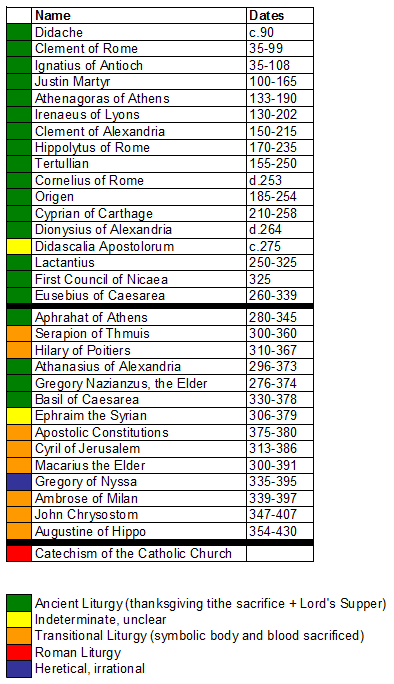
That’s at least twelve sources from before the late 4th century that describe a liturgy that is different from the Roman Catholic liturgy. This does not include the five that CE cited, which don’t describe the Roman Catholic liturgy either. Including the contested sources, that’s 17 sources in total that defend the ancient liturgy of the unconsecrated tithe sacrifice and a Lord’s Supper of consecrated elements. Add in the three more from the late 4th century, and you get 20 different sources.
Now, let’s go back and examine CE’s claim:
So, we have another church father who believes the sacrifice of Christ is re-presented in the mass through bread and wine becoming the body and blood of Christ. [..] I could go much further in time, but Tim has claimed that the sacrifice of the mass and the Eucharist being holy communion was invented in the 4th century, so I don’t think I’ll need to go any further since I wouldn’t be disproving his claim by using quotes from the 4th century and behind. Adios.
CE isn’t wrong to object that the Roman Catholic eucharist was invented in the late 4th century. We agree, it was not.
What happened in the late fourth century is that the church began to offer the eucharist as a sacrifice of consecrated bread and wine which symbolically represented the body and blood of Christ. This change—attested to by eight different sources—rapidly became the consensus theology over (roughly) a single generation (during the rise of Roman Catholicism).
But this symbolic sacrifice of the late fourth century is not the Roman Catholic doctrine of The Real Presence, where the literal body and blood of Christ are offered in the “sacrifice of the mass.” As CE notes, that actually developed much further forward in time during the more recent centuries.
The liturgy of the late fourth century was transitional. So, Catholic Enthusiast, we will concede the point: the Roman Catholic eucharist—what you call the Holy Communion—was not invented in the late fourth century. It did not originate until at least the 5th or 6th century.

But this symbolic sacrifice of the late fourth century is not the Roman Catholic doctrine of The Real Presence, where the literal body and blood of Christ are offered in the “sacrifice of the mass.” As CE notes, that actually developed much further forward in time during the more recent centuries.
The liturgy of the late fourth century was transitional. So, Catholic Enthusiast, we will concede the point: the Roman Catholic eucharist—what you call the Holy Communion—was not invented in the late fourth century. It did not originate until at least the 5th or 6th century.
This is similar to how ”rp” saints and ”leaders” fraudulently claim St.Rollo is the ”Father ” of the ”red pill” even though they mainly copy the PUAGAME=siteen commandments of h@t p@on of King Roissy=Heartiste and mix it confusingly and stupidly in with the Biblical Patriarchy of GBFMS often heavy-duty Scripture quoting onslaught that they will in turn call ”noise”yet when they do it it is the TRUTH that sets MEN free to be slaves to gina and butt tingles and their tradconnic JESUS-hating beauracacy Government that they themselves the ”rp” saints” and ”leaders” like their idols elrushbo and W.Bush never submitted to militaristicaly while being cowards who call pacifists cowards-whose the coward the one who never serves under the governments flag but tells others too or the one that preaches don’t serve under any government flag and never has?
As Doc Savage said in ’04”why hasn’t Limbaugh joined the military yet(he’s still young enough to serve-which is true for the gung ho ”rp” saints and ”leaders” who tell other MEN to serve and they COWARDLY don’t because they are in the words of a troll that comes here ”too scaredeth & chicken$#itted like our idols Elrushbo & W.Bush) since he’s so gung ho on the irag & Afghanistan wars?
Anyway here’s what a so-called saint said(who mysteriously can’t find his way to a certain site again even though today’s post is unspokenly in his honour).
thedeti says:
7 October, 2024 at 4:23 pm
Exit question — have you ever seen anything like that in a western made movie?
The only scene I can think of now is in Godfather Part II where Michael’s new Italian wife is in private with him, and openly removes her slip to “present” herself to him sexually. It’s not presented as lustful or manipulative. It’s presented more as a new, young wife giving herself to her husband.
&
thedeti says:
7 October, 2024 at 4:49 pm
In the first flick, he is a young man on the run from the bad guys. He comes upon this hut in the countryside. Inside the hut is this woman and her early twenties daughter. They tell him to get lost. Then the bad guys come and Musashi dispatches them in short order.
What happens next is something that you probably wouldn’t see in an American flick. Both the woman and her daughter beg Musashi to f them right now. They place themselves in a physical position for this to happen. Musashi looks at them in disgust, and walks away.
This can be interpreted a couple of different ways.
–The woman and her daughter are genuinely sexually aroused, and want to fuck Musashi. They’re aroused because a masculine man just saved their lives and because terror and sexual arousal produce pretty much the same physiological responses in humans.
–The woman and her daughter are genuinely terrified of Musashi and are offering themselves to him sexually in the hopes he won’t kill them. In this case the two women are subtly manipulating Musashi to persuade him not to kill them.
Rollo has written before of War Brides in which the women of a vanquished or occupied nation intermarry with their male conquerors. Rollo postulated the women did this due to sexual attraction. That’s a good explanation. It’s been a while since I read Rollo on this; but he might also have posited that women do this to manipulate the men into not killing them.
Rollo comes close to this by suggesting women intermarry with their occupiers/conquerors because they evolved to adapt to their new surroundings and the new men exercising hard power. They had men who had that hard power, but other, stronger men defeated and killed them; and so now the surviving women must make do with the men who have power over them.
[Sounds very patriarchal it does]
This(Biblical Patriarchy) was first proclaimed by GBFM{unlike their saints and ”leaders ” who instead preached a license of licentiousness to sin or game (or their true version now of ”holy” yanking and cranking while watching p@rn and enjoying the decline with a head and heart filled with unholy lust} which they copied from him without acknowledgment but stolen valour like tradcons are well-known for as they gleefully watch (while clapping their innocent blood-stained hands of societal murder as they pushed for abortion while supposedly opposing it too)western Civ collapse under their folly & gross and perverted mismanagement.
Men are tribal. Women in general are not.
In those “times gone by” women of a vanquished city or nation, gave themselves over not because they were “sexually aroused” by “real men” but for just plain survival instinct.
I mean, today, many have zero problem blowing up a marriage, ruining a husband through the courts in protecting herself and securing assets.
In that prepper group I belonged to briefly years ago….real “manly men” more concerned not about survival, but “all the women that are gonna want to f*ck us because we will have the resources”
I mentioned offhand, “many probably would but they would run off and tell their gansta / thug boyfriends who didnt prepare and they would then come over and take us over. Female nature is fickle here. I mean, even in “Clerks” Dante’s girlfriend mentioned offhand that she had sucked “33 d*cks” and didnt think much of it.
Typical of the ‘sphere, its all about sex and what women “find” attractive and then these men tell us what we have to learn. We have to do what women find attractive. They cater to their every whim.
In the Dischord I belong to, the topic came up about “church”
And few men are professed believers.
I mentioned that some men want a church with an organ, traditional hymns and a pastor / vicar that sometimes gives a good old fashioned “fire and brimstone” sermon on repentance. I also mentioned that believers and members of a church…..not somebody new(er) should be expected to be setting an example in Gods House of being dressed properly (shirt and tie) and this “flip-flop / sandals / baseball caps in church” to me as a man shows actually some disrespect in His house.
I was wrong on that too evidently.
So what these men want is a church is : relationship / relational. Heart matters. A femme church, but women have to cover their heads. No single moms, unless their husband died in a war in the US military. No women with tattoos. No women who are fat. No women who kissed someone, not even once. There, “we real men” brought back the “patriarchy” to the church, now how come men dont come???????????????????????????????????? They must be wimps and soy-boys!
Of course, I was wrong….Jesus is about “heart matters” and “relationships” (things that women want more than men from the church). Men just “want to be men” (ask them to define that, the usual PUA playbook)
And who is stopping them now???? No one.
Pingback: Sacraments, Part 2: Tertullian